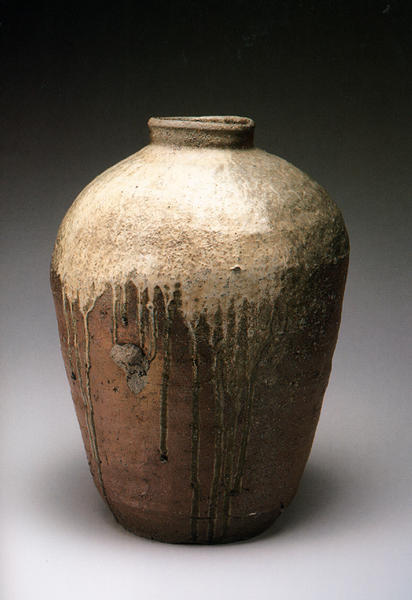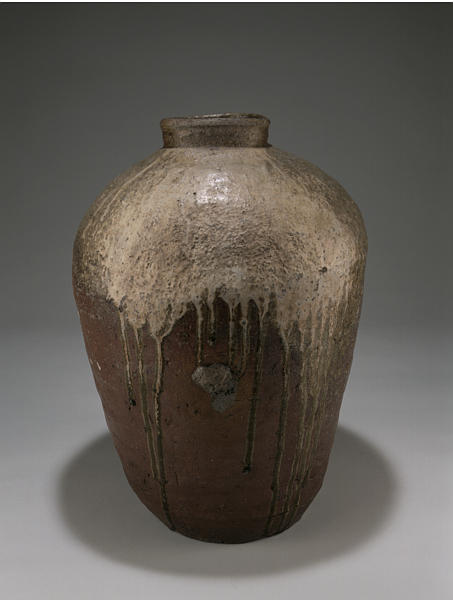丹波壺
- 兵庫県・丹波窯
- 南北朝時代
- 14c
- 自然釉陶
- H-47.8 D-35
丹波焼は中世以来続いた代表的な古窯の一つで、その窯跡は現在の兵庫県今田町(こんだちょう)の小野原、立杭、釜屋周辺の山麓に散在する。開窯時期は鎌倉時代初期の十二世紀末といわれ、初期の作品には常滑焼の強い影響がみられる。十五世紀に入ると濃い褐色の肌に青緑色の自然釉がかかった重厚な趣の壺が焼かれるようになるが、茶入や花入などいわゆる茶陶が焼き始められるのは他の諸窯より遅れ、桃山時代の後期とされている。現在では立杭焼としてその名が知られている。
この壺は玉縁づくりをもった立ち上がりの短い口頸部をもつ。口づくりの形状からすると室町時代に分類されるものであるが、長胴形にしては底部が大きい寸胴形であることから、南北朝時代(十四世紀中頃)の作と思われる。胴部中ほどには隣接した器の一部がひっつきとなり、出臍のように残っている。底脇には底を成形した際の削りがみられる。この種のものは備前か丹波かどこで焼かれたか判然としないところから備丹(びーたん)といわれる。器形もよく、器肌はよく焼き締まって淡い茶褐色を呈し、肩にかかった白い自然釉が滝のように流下し次第に緑色に変化する色合いが美しい。
丹波(たんば)
兵庫県今田町(こんだちょう)の小野原(おのばら)、立杭(たちくい)、釜屋(かまや)の諸窯で焼かれたものです。開窯時期は鎌倉時代初期の12世紀末といわれ、初期の作品には常滑焼の強い影響がみられます。15世紀に入ると濃い褐色の肌に青緑色の自然釉がかかった重厚な趣の壺が焼かれるようになります。茶入や花入など、いわゆる茶陶が焼き始められるのは他の諸窯より遅れ、桃山時代の後期とされています。現在では立杭焼としてその名が知られています。
解説(開館1周年記念展)
丹波焼は中世以来続いた代表的な古窯の一つで,その窯跡は現在の兵庫県今田町の小野原,立杭,釜屋周辺の山麓に散在する。開窯時期は鎌倉時代初期の12世紀末といわれ,初期の作品には常滑焼の強い影響がみられる。15世紀に入ると濃い褐色の肌に青緑色の自然釉が掛かった重厚な趣の壷が焼かれるようになるが,茶入や花入などいわゆる茶陶が焼き始められるのは他の諸窯より遅れ,桃山時代の後期とされている。現在では立杭焼としてその名が知られている。
この壷は玉縁づくりで立ち上がりの短い口頚部をもつ。口づくりの形状からすると室町時代に分類されるものであるが,長胴形にしては底部が大きい寸胴形であることから,南北朝時代(14世紀中頃)の作と思われる。胴部中ほどには隣接した器の一部がひっつきとなり,出臍のように残っている。底脇には底を成形した際の削りがみられる。この種のものは備前か丹波かどこで焼かれたか判然としないところから備丹といわれる。器形もよく,器肌はよく焼き締まって淡い茶褐色を呈し,肩に掛かった白い自然釉が滝のように流下し,次第に緑色に変化する色合いが美しい。
Catalogue Entry
Tanba is the site of one of the six classic ceramic kilns of Japan whose origin dates back to the medieval period. Tanba kilns are found at the foot of the mountains around Onobara, Tachikui and Kamaya areas of Konda-cho in Hyogo Prefecture. The history of ceramic production in this area can be traced back to the late 12th century, when production began. An influence from Tokoname ware is evident in early Tanba pieces. In the beginning of the 15th century, pots with bluish-green natural ash glaze contrasting against a deep brown clay surface began to be produced. The production of tea ware, such as tea containers and flower vases, did not begin until the second half of the Momoyama period (1573-1615), later than other ceramic producing areas. Tanba ware is also known today as Tachikui ware.
This jar has a short neck with rounded lip. Because of the shape of the mouth, this piece may perhaps have been produced in the Muromachi period (1392-1573), although it is more likely to have been produced in the mid-14th century in the Nanbokucho period (1336-1392), judging from the overall shape of the jar a slight taper of a rather long body toward a broad bottom. A piece adjacent to this jar during the firing appears to have touched it, producing a protrusion like a navel in the middle of the jar's body. There is evidence of shaving of excess clay on the jar close to the bottom. This kind of jar is referred to as btan "Bizen and Tanba," since it is not clear if it was fired in Bizen or Tanba. This jar, with light reddish brown color of the clay and a graceful shape, was fired with a considerable level of expertise. The natural ash glaze changes its color from white to green as it cascades down from the shoulders, making this piece all the more exquisite.

